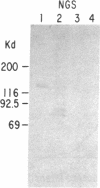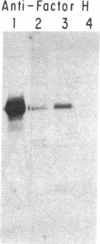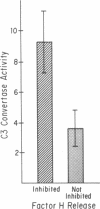Abstract
The alternative pathway of complement is regulated on the surface of homologous blood cells at the C3 amplification step by the membrane protein decay-accelerating factor, as well as by the plasma protein factor H. We have reported elsewhere that platelets from patients with paroxysmal nocturnal hemoglobinuria regulate the activity of the C3 convertase C3bBb, even though they lack decay-accelerating factor. We now report that normal human platelets contain factor H, which was released from the platelet in response to complement deposition or thrombin stimulation. Factor H was localized to the platelet alpha granules by immunocytochemical techniques. As determined by a solid-phase radioimmunoassay, thrombin-stimulated platelets released approximately equal to 54 ng of factor H per 10(8) platelets. The release of factor H in response to complement or thrombin was inhibited by treating the platelets with metabolic inhibitors. Such inhibition resulted in a 3-fold increase in the activity of C3bBb. Platelets that released factor H bound only half as many molecules of radiolabeled factor B to platelet-bound C3b than platelets that could not release factor H. Treatment of platelets with anti-decay-accelerating factor antibody had no effect on the activity of C3bBb unless the release of factor H was blocked. Therefore, so far as we know, human platelets have a unique mechanism for the regulation of the alternative pathway of complement.
Full text
PDF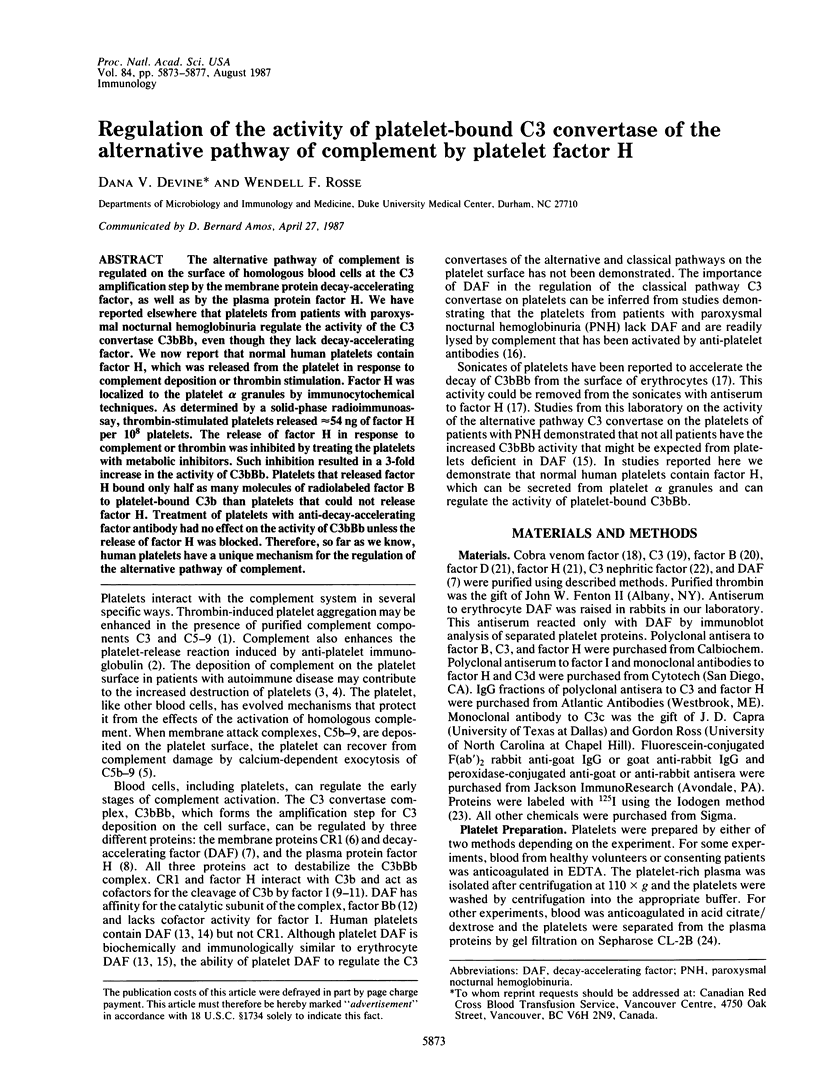
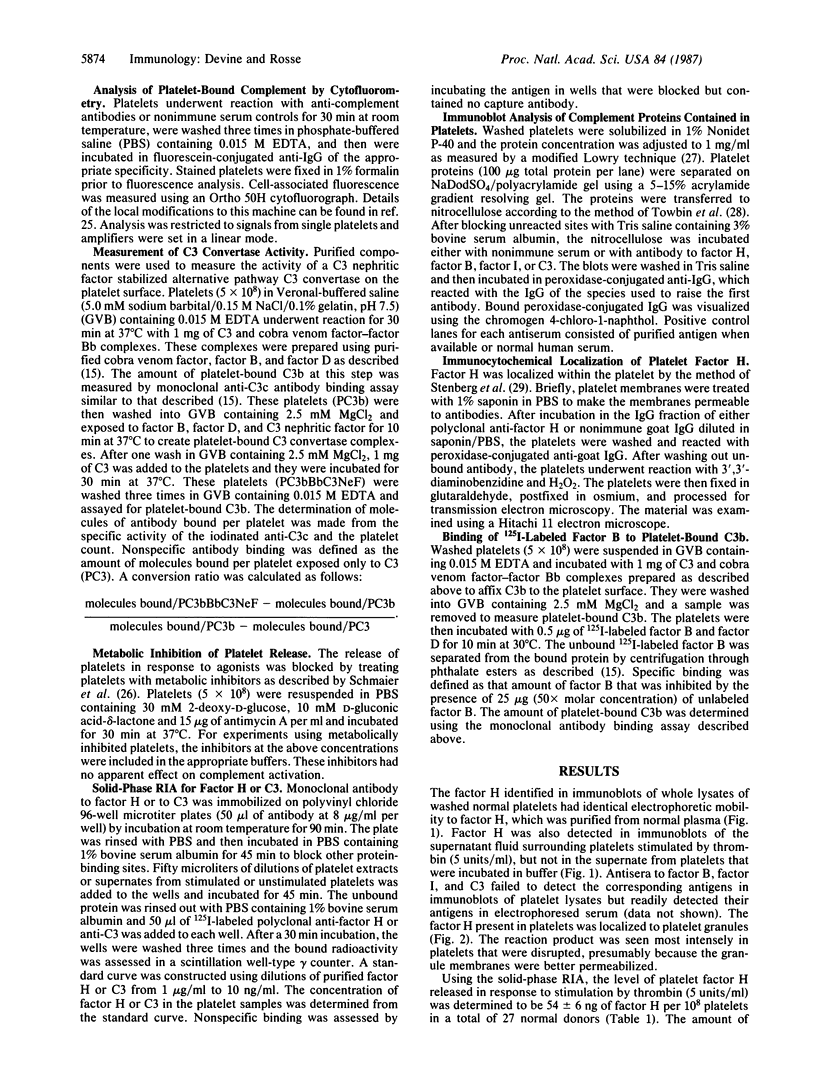
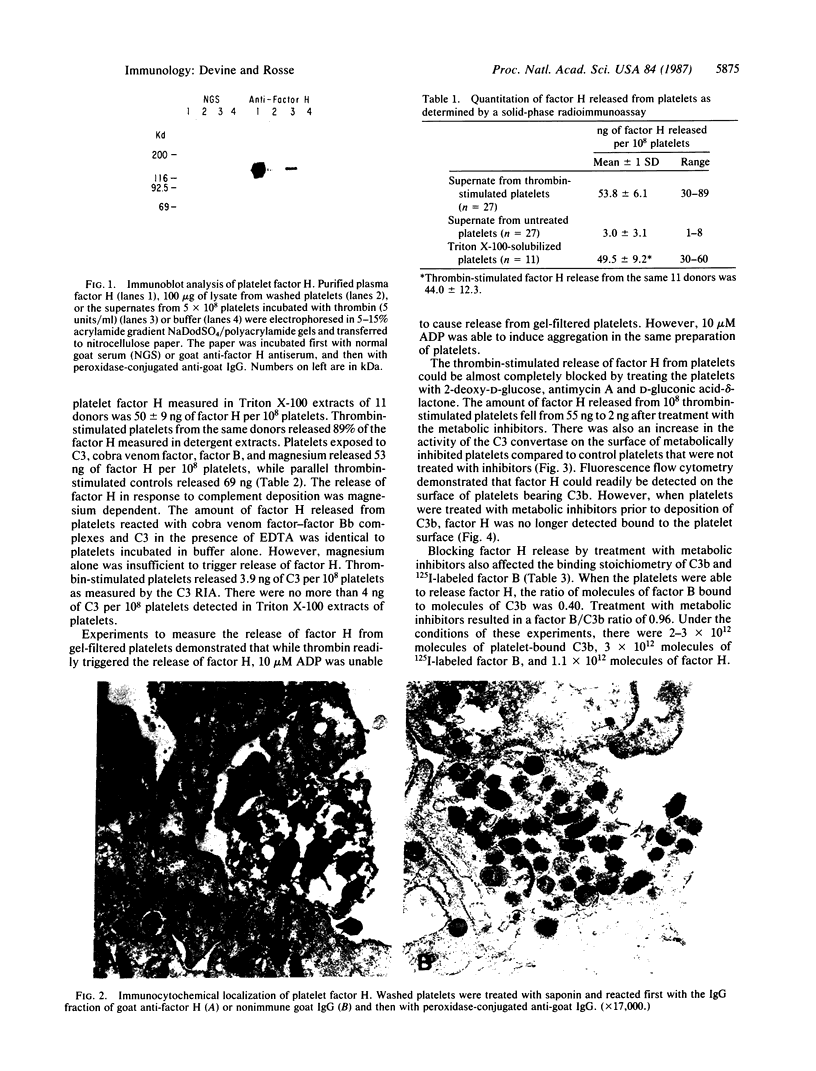
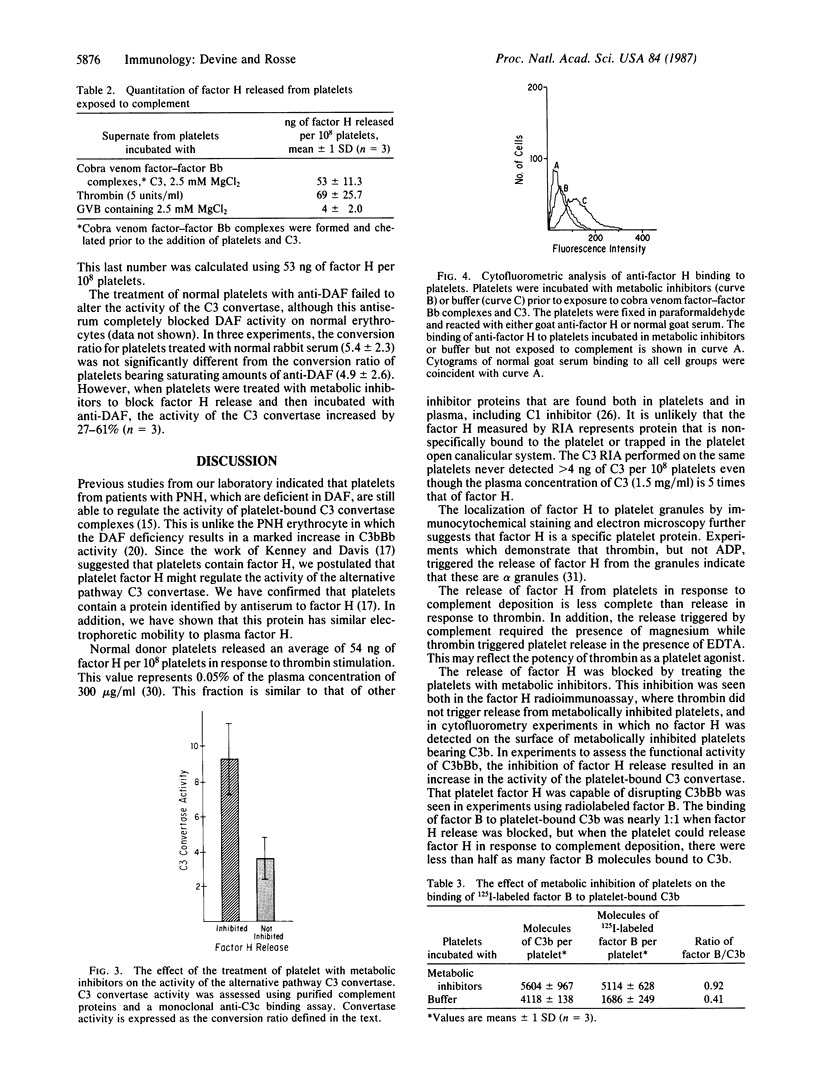
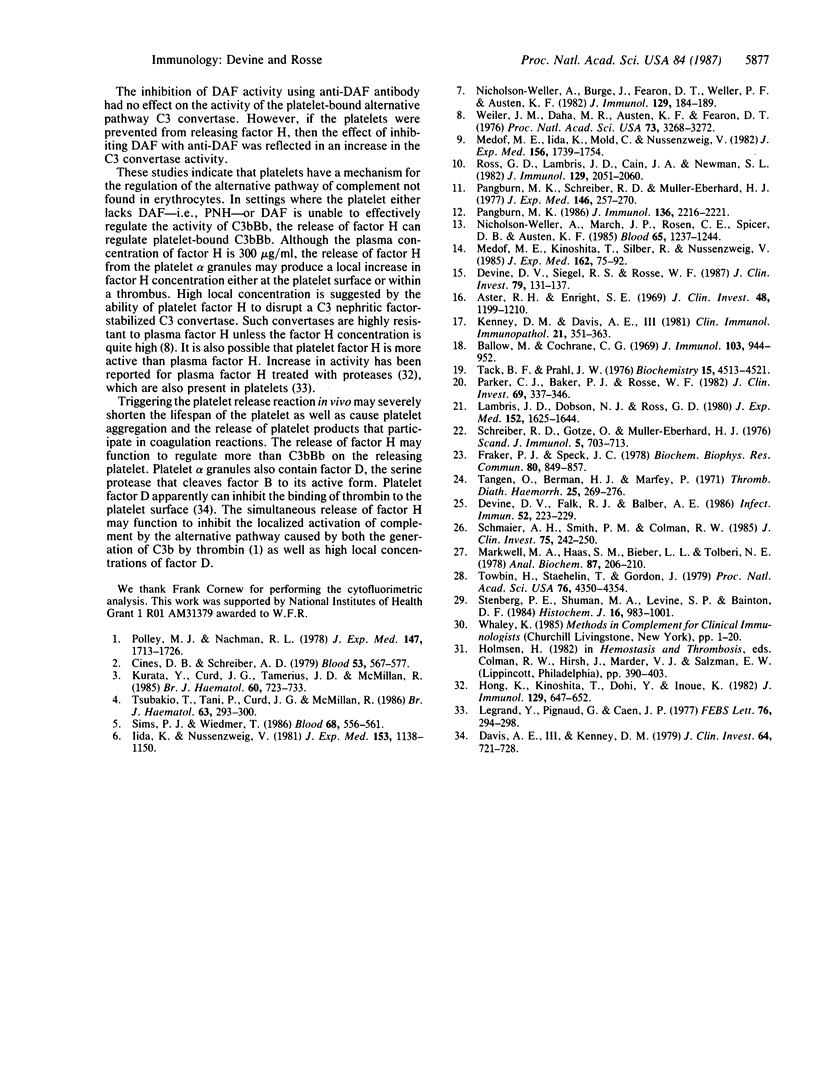
Images in this article
Selected References
These references are in PubMed. This may not be the complete list of references from this article.
- Aster R. H., Enright S. E. A platelet and granulocyte membrane defect in paroxysmal nocturnal hemoglobinuria: usefulness for the detection of platelet antibodies. J Clin Invest. 1969 Jul;48(7):1199–1210. doi: 10.1172/JCI106084. [DOI] [PMC free article] [PubMed] [Google Scholar]
- Ballow M., Cochrane C. G. Two anticomplementary factors in cobra venom: hemolysis of guinea pig erythrocytes by one of them. J Immunol. 1969 Nov;103(5):944–952. [PubMed] [Google Scholar]
- Cines D. B., Schreiber A. D. Effect of anti-P1A1 antibody on human platelets. I. The role of complement. Blood. 1979 Apr;53(4):567–577. [PubMed] [Google Scholar]
- Davis A. E., 3rd, Kenney D. M. Properdin factor D: effects on thrombin-induced platelet aggregation. J Clin Invest. 1979 Sep;64(3):721–728. doi: 10.1172/JCI109515. [DOI] [PMC free article] [PubMed] [Google Scholar]
- Devine D. V., Falk R. J., Balber A. E. Restriction of the alternative pathway of human complement by intact Trypanosoma brucei subsp. gambiense. Infect Immun. 1986 Apr;52(1):223–229. doi: 10.1128/iai.52.1.223-229.1986. [DOI] [PMC free article] [PubMed] [Google Scholar]
- Devine D. V., Siegel R. S., Rosse W. F. Interactions of the platelets in paroxysmal nocturnal hemoglobinuria with complement. Relationship to defects in the regulation of complement and to platelet survival in vivo. J Clin Invest. 1987 Jan;79(1):131–137. doi: 10.1172/JCI112773. [DOI] [PMC free article] [PubMed] [Google Scholar]
- Fraker P. J., Speck J. C., Jr Protein and cell membrane iodinations with a sparingly soluble chloroamide, 1,3,4,6-tetrachloro-3a,6a-diphrenylglycoluril. Biochem Biophys Res Commun. 1978 Feb 28;80(4):849–857. doi: 10.1016/0006-291x(78)91322-0. [DOI] [PubMed] [Google Scholar]
- Hong K., Kinoshita T., Dohi Y., Inoue K. Effect of trypsinization on the activity of human factor H. J Immunol. 1982 Aug;129(2):647–652. [PubMed] [Google Scholar]
- Iida K., Nussenzweig V. Complement receptor is an inhibitor of the complement cascade. J Exp Med. 1981 May 1;153(5):1138–1150. doi: 10.1084/jem.153.5.1138. [DOI] [PMC free article] [PubMed] [Google Scholar]
- Kenney D. M., Davis A. E., 3rd Association of alternative complement pathway components with human blood platelets: secretion and localization of factor D and beta 1H Globulin. Clin Immunol Immunopathol. 1981 Dec;21(3):351–363. doi: 10.1016/0090-1229(81)90224-5. [DOI] [PubMed] [Google Scholar]
- Kinoshita T., Medof M. E., Silber R., Nussenzweig V. Distribution of decay-accelerating factor in the peripheral blood of normal individuals and patients with paroxysmal nocturnal hemoglobinuria. J Exp Med. 1985 Jul 1;162(1):75–92. doi: 10.1084/jem.162.1.75. [DOI] [PMC free article] [PubMed] [Google Scholar]
- Kurata Y., Curd J. G., Tamerius J. D., McMillan R. Platelet-associated complement in chronic ITP. Br J Haematol. 1985 Aug;60(4):723–733. doi: 10.1111/j.1365-2141.1985.tb07477.x. [DOI] [PubMed] [Google Scholar]
- Lambris J. D., Dobson N. J., Ross G. D. Release of endogenous C3b inactivator from lymphocytes in response to triggering membrane receptors for beta 1H globulin. J Exp Med. 1980 Dec 1;152(6):1625–1644. doi: 10.1084/jem.152.6.1625. [DOI] [PMC free article] [PubMed] [Google Scholar]
- Legrand Y., Pignaud G., Caen J. P. Purification of platelet proteases: activation of proelastase by a trypsin-like enzyme. FEBS Lett. 1977 Apr 15;76(2):294–298. doi: 10.1016/0014-5793(77)80171-3. [DOI] [PubMed] [Google Scholar]
- Markwell M. A., Haas S. M., Bieber L. L., Tolbert N. E. A modification of the Lowry procedure to simplify protein determination in membrane and lipoprotein samples. Anal Biochem. 1978 Jun 15;87(1):206–210. doi: 10.1016/0003-2697(78)90586-9. [DOI] [PubMed] [Google Scholar]
- Medof M. E., Iida K., Mold C., Nussenzweig V. Unique role of the complement receptor CR1 in the degradation of C3b associated with immune complexes. J Exp Med. 1982 Dec 1;156(6):1739–1754. doi: 10.1084/jem.156.6.1739. [DOI] [PMC free article] [PubMed] [Google Scholar]
- Nicholson-Weller A., Burge J., Fearon D. T., Weller P. F., Austen K. F. Isolation of a human erythrocyte membrane glycoprotein with decay-accelerating activity for C3 convertases of the complement system. J Immunol. 1982 Jul;129(1):184–189. [PubMed] [Google Scholar]
- Nicholson-Weller A., March J. P., Rosen C. E., Spicer D. B., Austen K. F. Surface membrane expression by human blood leukocytes and platelets of decay-accelerating factor, a regulatory protein of the complement system. Blood. 1985 May;65(5):1237–1244. [PubMed] [Google Scholar]
- Pangburn M. K. Differences between the binding sites of the complement regulatory proteins DAF, CR1, and factor H on C3 convertases. J Immunol. 1986 Mar 15;136(6):2216–2221. [PubMed] [Google Scholar]
- Pangburn M. K., Schreiber R. D., Müller-Eberhard H. J. Human complement C3b inactivator: isolation, characterization, and demonstration of an absolute requirement for the serum protein beta1H for cleavage of C3b and C4b in solution. J Exp Med. 1977 Jul 1;146(1):257–270. doi: 10.1084/jem.146.1.257. [DOI] [PMC free article] [PubMed] [Google Scholar]
- Parker C. J., Baker P. J., Rosse W. F. Increased enzymatic activity of the alternative pathway convertase when bound to the erythrocytes of paroxysmal nocturnal hemoglobinuria. J Clin Invest. 1982 Feb;69(2):337–346. doi: 10.1172/JCI110457. [DOI] [PMC free article] [PubMed] [Google Scholar]
- Polley M. J., Nachman R. The human complement system in thrombin-mediated platelet function. J Exp Med. 1978 Jun 1;147(6):1713–1726. doi: 10.1084/jem.147.6.1713. [DOI] [PMC free article] [PubMed] [Google Scholar]
- Ross G. D., Lambris J. D., Cain J. A., Newman S. L. Generation of three different fragments of bound C3 with purified factor I or serum. I. Requirements for factor H vs CR1 cofactor activity. J Immunol. 1982 Nov;129(5):2051–2060. [PubMed] [Google Scholar]
- Schmaier A. H., Smith P. M., Colman R. W. Platelet C1- inhibitor. A secreted alpha-granule protein. J Clin Invest. 1985 Jan;75(1):242–250. doi: 10.1172/JCI111680. [DOI] [PMC free article] [PubMed] [Google Scholar]
- Schreiber R. D., Götze O., Müller-Eberhard H. J. Nephritic factor: its structure and function and its relationship to initiating factor of the alternative pathway. Scand J Immunol. 1976;5(6-7):705–713. doi: 10.1111/j.1365-3083.1976.tb03020.x. [DOI] [PubMed] [Google Scholar]
- Sims P. J., Wiedmer T. Repolarization of the membrane potential of blood platelets after complement damage: evidence for a Ca++ -dependent exocytotic elimination of C5b-9 pores. Blood. 1986 Aug;68(2):556–561. [PubMed] [Google Scholar]
- Stenberg P. E., Shuman M. A., Levine S. P., Bainton D. F. Optimal techniques for the immunocytochemical demonstration of beta-thromboglobulin, platelet factor 4, and fibrinogen in the alpha granules of unstimulated platelets. Histochem J. 1984 Sep;16(9):983–1001. doi: 10.1007/BF01003853. [DOI] [PubMed] [Google Scholar]
- Tack B. D., Prahl J. W. Third component of human complement: purification from plasma and physicochemical characterization. Biochemistry. 1976 Oct 5;15(20):4513–4521. doi: 10.1021/bi00665a028. [DOI] [PubMed] [Google Scholar]
- Towbin H., Staehelin T., Gordon J. Electrophoretic transfer of proteins from polyacrylamide gels to nitrocellulose sheets: procedure and some applications. Proc Natl Acad Sci U S A. 1979 Sep;76(9):4350–4354. doi: 10.1073/pnas.76.9.4350. [DOI] [PMC free article] [PubMed] [Google Scholar]
- Tsubakio T., Tani P., Curd J. G., McMillan R. Complement activation in vitro by antiplatelet antibodies in chronic immune thrombocytopenic purpura. Br J Haematol. 1986 Jun;63(2):293–300. doi: 10.1111/j.1365-2141.1986.tb05552.x. [DOI] [PubMed] [Google Scholar]
- Weiler J. M., Daha M. R., Austen K. F., Fearon D. T. Control of the amplification convertase of complement by the plasma protein beta1H. Proc Natl Acad Sci U S A. 1976 Sep;73(9):3268–3272. doi: 10.1073/pnas.73.9.3268. [DOI] [PMC free article] [PubMed] [Google Scholar]



